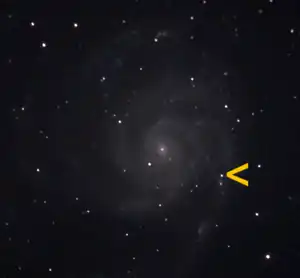 Supernova 2023ixf as seen on 20 May 2023 05:58 UT | |
| Type II-L supernova (single massive star) | |
| Date | 19 May 2023 17:27[1] |
|---|---|
| Constellation | Ursa Major |
| Right ascension | 14h 03m 38.6s[2] |
| Declination | +54° 18′ 42.1″[2] |
| Epoch | J2000 |
| Distance | 21 Mly (6.4 Mpc)[2] |
| Host | Pinwheel Galaxy (M101) NGC 5461[3] |
| Progenitor | Supergiant (M=–4.66)[4] |
| Peak apparent magnitude | 10.8 (on 22 May 2023)[5][6] |
| | |
SN 2023ixf is a type II-L[7][8] (core collapse) supernova located in the Pinwheel Galaxy (M101). It was first observed on 19 May 2023 by Kōichi Itagaki and immediately classified as a type II supernova.[2] Initial magnitude at discovery was 14.9.[2] After discovery, the Zwicky Transient Facility project found a precovery image of the supernova at magnitude 15.87 two days before discovery.[9] The supernova is about 21 million light-years from Earth and is expected to have left behind either a neutron star or black hole based on current stellar evolution models.
The supernova is located near a prominent HII region, NGC 5461, in an outer spiral arm of the bright galaxy.[3]
By 22 May 2023 SN 2023ixf had brightened to about magnitude 11.[5][6] It can be seen in telescopes as small as 114 mm (4.5 in)[3] and should remain visually visible with backyard telescopes for a few months.[10] The last supernova this close to Earth was SN 2014J in Messier 82, roughly 12 million light-years from Earth. The supernova started to fade on around 10 June 2023.[11]
| Supernova | Galaxy | Distance | Type | Peak apmag |
|---|---|---|---|---|
| SN 2023ixf | Pinwheel Galaxy (M101) | 21 Mly (6.4 Mpc) | II | 10.8 |
| SN 2014J | M82 (Cigar Galaxy) | 12 Mly (3.7 Mpc) | Ia | 10.1[12] |
| SN 2011fe | Pinwheel Galaxy (M101) | 21 Mly (6.4 Mpc) | Ia | 9.9[13] |
Before becoming a supernova, the progenitor star is believed to have been a supergiant with an absolute magnitude in the near-infrared (814nm) of MF814W = –4.66.[4]
References
- ↑ "Discovery certificate for object 2023ixf". Transient Name Server. Archived from the original on 2023-05-21. Retrieved 2023-05-22.
- 1 2 3 4 5 "AstroNote 2023-119". Transient Name Server. Archived from the original on 2023-05-20. Retrieved 2023-05-20.
- 1 2 3 Bob King (2023-05-22). "Bright Supernova Blazes in M101, the Pinwheel Galaxy". Sky & Telescope. Archived from the original on 2023-05-22. Retrieved 2023-05-23.
- 1 2 "Detection of candidate progenitor of SN 2023ixf in HST archival data". Astronomer's Telegram. 2023-05-23. Archived from the original on 2023-05-24. Retrieved 2023-05-24.
- 1 2 David Bishop. "2023ixf (ZTF23aaklqou)". Archived from the original on 2023-05-21. Retrieved 2023-05-22.
- 1 2 "2023-141: Amateur Follow-up observations in bands V & B". Transient Name Server.
- ↑ G., Bianciardi; M., Ciccarelli A.; G., Conzo; M., D'Angelo; S., Ghia; M., Moriconi; Z., Orbanić; N., Ruocco; I., Sharp; M., Uhlár; F, Walter (2023). "Multiband Photometry Evolution in the First Weeks of SN 2023ixf, a possible II-L Subtype Supernova". Transient Name Server Astronote. 213: 1. arXiv:2307.05612. Bibcode:2023TNSAN.213....1B.
- ↑ "VSX : Detail for SN 2023ixf". www.aavso.org. Retrieved 2023-07-31.
- ↑ "ZTF Pre-Discovery Forced Photometry of SN 2023ixf". Transient Name Server.
- ↑ Kelly Kizer Whitt (2023-05-20). "New supernova! Closest in a decade". Earthsky. Archived from the original on 2023-05-20. Retrieved 2023-05-21.
- ↑ "AAVSO Magnitude Plot". AAVSO. Archived from the original on 2023-06-11.
- ↑ List of supernovae sorted by Magnitude for 2014 Archived 2023-05-30 at the Wayback Machine (David Bishop)
- ↑ List of supernovae sorted by Magnitude for 2011 Archived 2023-05-30 at the Wayback Machine (David Bishop)
External links
- Supernova Discovered in Nearby Spiral Galaxy M101, Astronomy Picture of the Day (NASA)
- AAVSO: magnitude plot
.png.webp)
